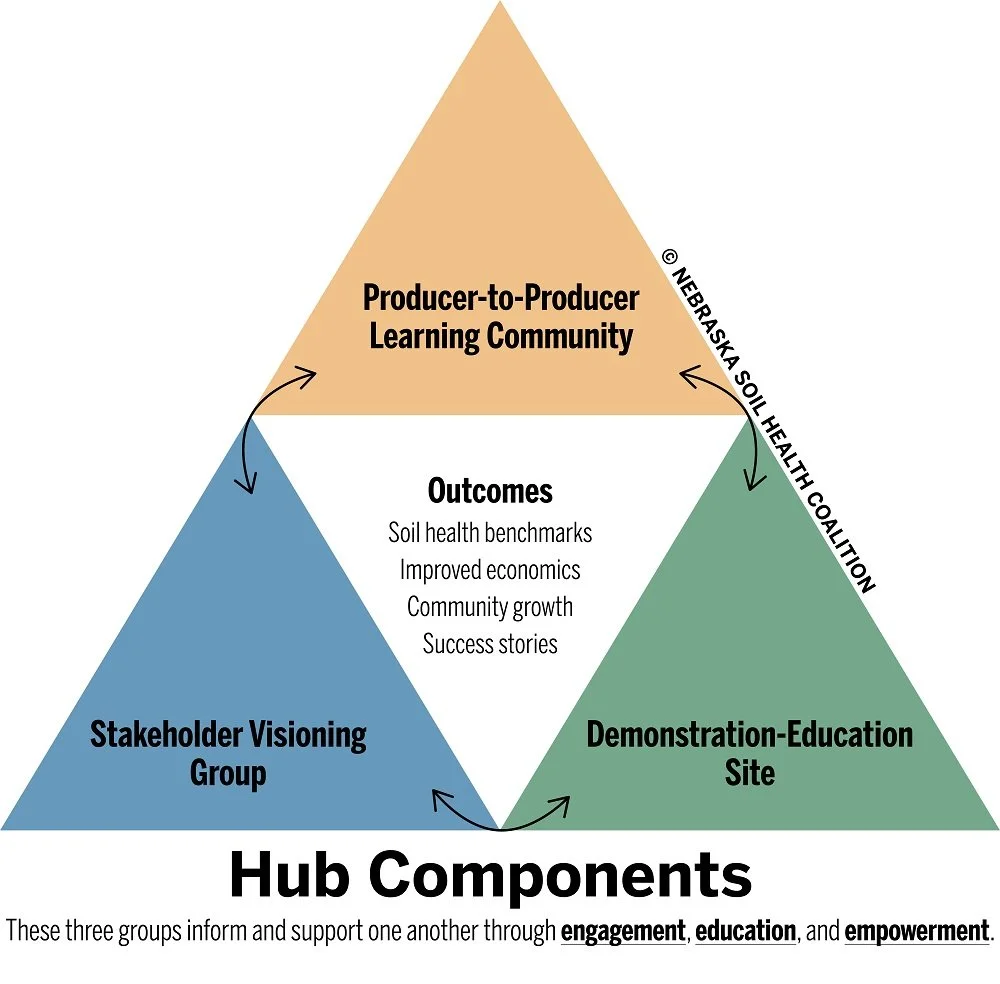The Rest of the Story: Soil Health, Community, and a Vision for Nebraska
MEDIA CONTACT:
Mike McDonald, producer at Palmyra; NSHC Board member; lifelong Nebraskan
Email: mcdonald1.mike@gmail.com
Phone: (402) 314-1571
Also featured in the Aurora News-Register!
Paul Harvey’s iconic sign-off—“And now you know the rest of the story”—captivated more than 24 million weekly listeners from 1951 to 2008. His legendary piece “So God Made a Farmer” resonates to this day, celebrating the spirit of rural America. If Harvey were alive today, we believe he’d champion a Nebraska-rooted, community-led movement that’s redefining stewardship and sustainability.
Here’s the rest of the story—in 2025.
Over the past year, board members of the Nebraska Soil Health Coalition (NSHC) have been sharing stories of local leaders transforming agriculture from the ground up. Most recently, the Aurora News-Register and NSHC are exploring a series. This article highlights the South Central Hub, based around Hastings, the first of five planned hubs statewide. Hub 2, launching in southwest Nebraska, extends west from the original hub. Our collaboration with the Nebraska Community Foundation marks a national first: a community-focused model for soil health advancement.
Our approach—outlined at nesoilhealth.org and on the image is built around three pillars:
Producer Learning Communities (PLC)
Demonstration-Education Sites (DES)
Stakeholder Visioning Groups (SVG)
The Nebraska Soil Health Coalition Board is forming Hubs across Nebraska to focus on soil health. The components of each Hub include a producer-to-producer learning community, a demonstration-education site and a stakeholder visioning group (SVG) to create outcomes including soil health benchmarks, improved economics, community growth and success stories.
This article focuses on the SVG, which fosters deep, long-lasting relationships that align economic outcomes with stewardship. Trust is the foundation—so that farmers, lenders, and landowners can work collaboratively toward improved soil health and a stronger return on investment. Producers such as Zach Mader (Grand Island), Jay Goertzen (Henderson), and Brian Berns (Bladen) are establishing the foundation to intentionally develop rural-urban ties.
One SVG leader, Michele Bever, Executive Director of the South Heartland District Health Department, brings a vital public health perspective. Alongside over 20 local influencers—from farmers and landowners to lenders, educators, and healthcare professionals—Michele helps guide Hub 1’s efforts. Since 2023, five sessions and numerous community conversations have shaped a shared vision.
From these discussions, four guiding themes have surfaced:
Human health
Water quality
Agricultural systems and new markets
Pathways to meaningful change
SVG participants recognize that sustainable agriculture is not only about soil—it’s about clean water, community health, and generational impact. “Community health has a direct relationship with all walks of life,” Michelle shared, “but particularly with producers.”
Data and local stories point to serious challenges: the relationship between contaminants like nitrates and arsenic and diseases such as non-Hodgkin lymphoma. But the SVG isn't about blame—it’s about building trust and working together to solve real problems.
Michelle explains it best: “Change happens when it connects to people’s values and when support is sustained long-term.” That’s why our hub model is so critical—it integrates learning, demonstration, and visioning into a living framework for change.
Rising input costs—fertilizers, herbicides, seeds—are pushing producers to the brink. For new or young farmers, access to capital is a steep hurdle, and finding land to farm is even harder.
Meanwhile, longtime stewards of the land face their own dilemma: what happens when their children don’t want to farm?
That’s where new market opportunities—like diverse rotations and integrated livestock systems—can help sustain both soil and legacy.
The parallels between agriculture and medicine are striking. Just as “meaningful use” in healthcare promotes better outcomes, our work promotes practices that safeguard water and restore soil. Leaders like Marty Stange, retired Environmental Director for Hastings, now co-lead the SVG, blending environmental expertise with grassroots momentum.
Together, Michelle and Marty are helping chart a model for future hubs—including Hub 2 and beyond. Rural communities want more than growth—they want to attract and retain youth, and that means creating a place worth coming back to.
Paul Harvey reminded us that behind every headline is a deeper truth—and often, a hero in plain sight. Whether you’re in Hastings, Roseland, McCook, Imperial, or anywhere in between, you can be part of this movement.
Let’s build the rest of the story together to support NE papers, communities and producers.
About the Nebraska Soil Health Coalition
We are a collaborative effort to increase sustainable agricultural production and thriving rural communities. As part of that vision, we support Nebraska’s community newspapers. Our mission is to advance producer-centered education, outreach, and adoption of soil health principles to build resilient farms, ranches, and communities across Nebraska. You can learn more at www.nesoilhealth.org

